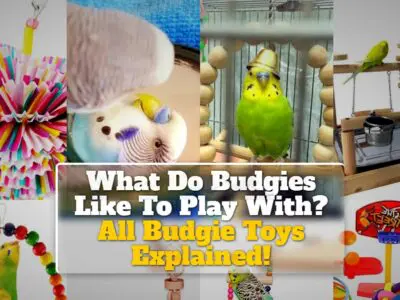Budgies like mostly activities that engage both their minds and bodies.
They enjoy socializing, playing with toys, and foraging for food.
Regular exercise, taking baths, listening to music, consuming a nutritious diet, chewing, and indulging in millet spray are among their favorite things.
As a bird lover and former budgie owner, I’ve spent many a happy hour observing these vibrant, energetic creatures.
Through careful observation, a bit of research, and drawing from my own experiences, I’ve discovered what truly delights these little feathered friends.
In this guide, I’ve categorized the nine key elements that make budgies happy. I also tried to explain how you can make your budgie happy under each category.
1. Interaction And Socialization 📺
Budgies thrive in social environments, their chirpy dispositions are a testament to their gregarious nature.
When we bring a budgie home, it’s important to remember they are accustomed to living in flocks.
Therefore, a single budgie craves constant interaction and company.
It is essential to carve out some time every day for your feathered friend to ensure they’re getting the companionship they need.
Some effective ways of socializing with your budgie include:
- Talking to them: Budgies are great listeners and find human speech fascinating. A simple conversation with your budgie can go a long way in making them feel loved and included.
- Singing to them: Budgies love music, and a soothing song can be an excellent way to bond with your budgie. They might even chirp along, creating a delightful duet!
- Including them in your daily routine: Budgies are curious creatures and enjoy being part of the daily household activities. Whether you’re cooking, cleaning, or even working on your laptop, your budgie will appreciate being involved.
- Gentle petting: Budgies, over time, can get accustomed to human touch and may enjoy light strokes on their head and neck. However, it’s important to approach them gently and cautiously to not frighten them.
For those with multiple budgies, they often form their mini social circles.
They love to interact with each other, chirping and preening in harmony.
Here’s what you might observe:
- Chirping contests: Budgies communicate using a series of chirps and tweets. When in a group, it’s common to witness chirping ‘contests’ where each bird tries to outdo the other in a playful exchange.
- Shared grooming sessions: Preening is an essential part of a budgie’s routine. In a group, budgies often preen each other, a behaviour known as allopreening, which helps strengthen their social bonds.
- Playful antics: Budgies are playful birds, and when in a group, they love to engage in playful activities. You might find them play-fighting, chasing each other, or sharing toys.
Through regular interaction and socialization, you can ensure your budgie’s emotional health while also strengthening your bond with them.
Your budgie’s happiness largely depends on the social engagement they receive, making this a crucial aspect of their care.
2. Toys
Just like young children, budgies love to play.
Toys not only keep these lively creatures entertained but also serve as an excellent source of mental and physical stimulation.
It’s crucial to offer your budgie a range of toys that cater to their innate instincts and preferences.
Here are some examples of budgie-approved toys:
- Chewing toys: Budgies have a natural instinct to chew. Providing them with safe chewing toys, made from materials such as untreated wood or bird-safe cardboard, can keep them entertained for hours while also maintaining the health of their beaks.
- Noise-making toys: Budgies are known for their vocal abilities, so it’s no surprise they love toys that make a sound. Bells or rattles can quickly become their favorite playthings.
- Mirrors: Many budgies enjoy interacting with their own reflection. A small mirror in their cage can provide hours of entertainment. However, it’s important to monitor their behavior to ensure they don’t become overly attached to their mirror “friend.”
- Puzzle toys: Budgies are incredibly intelligent and enjoy challenges. Toys that encourage them to solve a problem, like retrieving a treat from a complex contraption, can provide mental stimulation.
- Climbing toys: Physical activity is essential for a budgie’s health. Ladders, ropes, or swings in their cage promote exercise and are great for their muscle development and coordination.
When introducing a new toy, give your budgie time to get used to it.
It’s normal for them to be wary of new objects initially, but with time, they’ll likely start exploring and playing with it.
Remember, a well-stimulated budgie is a happy one, and toys are a great way to ensure they’re getting the mental and physical stimulation they need.
3. Foraging
In the wild, budgies spend a significant part of their day foraging for food.
This behavior is not only essential for their survival but also offers them physical exercise and mental stimulation.
Even in a domestic setting, budgies retain this instinctual behavior.
Encouraging this natural foraging instinct in your budgie can enhance their overall wellbeing and happiness.
To engage your budgie in foraging activities, consider the following:
- Foraging toys: These toys are specially designed to mimic the process of searching for food in the wild. They usually involve a food item being hidden or tucked away, forcing the bird to work a bit before it can eat.
- DIY foraging activities: You can create simple foraging activities at home by hiding treats in shredded paper or inside hollow toys. Watching your budgie solve these puzzles can be a source of great entertainment for both of you.
- Rotating the food dishes: A simple method to encourage foraging is to change the location of their food dishes inside the cage. This way, your budgie would have to ‘search’ for their food every day, providing some of the mental stimulation they’d get in the wild.
- Scattering food: Occasionally scattering a bit of their food at the bottom of the cage can also encourage foraging. However, ensure the cage bottom is clean to avoid any risk of disease.
- Using food skewers: Hanging chunks of fruits or veggies on a food skewer requires the bird to work a bit to get to the food, simulating a foraging experience.
These activities not only keep your budgie mentally and physically active but also provide an enriching environment that closely resembles their natural habitat.
Remember, for a budgie, the process of obtaining food is as rewarding as the food itself.
Hence, engaging them in foraging activities can contribute to their overall happiness and contentment.
4. Exercise
Budgies are energetic and active birds.
Exercise is integral to their overall health and happiness.
Here are some exercise activities that budgies often enjoy:
- Flying: Budgies are, after all, birds, and their natural instinct is to fly. Allowing your budgie to fly in a safe, controlled environment is one of the best forms of exercise. If you can’t let them out to fly, ensure their cage is big enough for them to flutter around.
- Climbing: Budgies love to climb. Installing ladders, ropes, or swings in their cage can encourage climbing and help maintain their muscle strength and coordination. Even something as simple as repositioning their perches can challenge them to climb and explore.
- Flapping: Even if your budgie is not able to fly freely, they can still get exercise from flapping their wings. You can encourage this behavior by gently lifting them off their perch, prompting them to flap their wings for balance.
- Playing with toys: Toys are not only great for mental stimulation, but they can also encourage physical activity. Puzzle toys, swinging toys, or noise-making toys can motivate your budgie to move and stretch.
- Dancing: Some budgies enjoy bobbing their head and ‘dancing’ to music. Playing some gentle music (preferably classical) can encourage this behavior, which also contributes to their physical activity.
5. Baths 📺
Bathing is an important activity for budgies, not just for cleanliness but also for their happiness.
Different budgies have different bathing preferences, and it’s important to figure out what suits your pet the best.
Here are some bathing options for budgies:
- Shallow dish baths: Many budgies enjoy splashing in a shallow dish of water. This dish could be as simple as a shallow bowl filled with water. It’s important to ensure that the dish isn’t too deep for the budgie to comfortably splash and bathe.
- Spray baths: Some budgies enjoy being gently misted with a spray bottle. This method mimics rain, which is how many birds in the wild bathe. When using this method, make sure the spray is fine and misty, not a direct jet of water.
- Bathing under a faucet: Some budgies like to bathe under a gently running faucet. You can set up a perch in the sink for your budgie to stand on and let the water run gently over them.
- Leaf baths: In the wild, many birds bathe by rubbing themselves against wet leaves. You can recreate this for your budgie by wetting some lettuce leaves and letting your budgie rub against them.
6. Music And Sound
Budgies are happy with sounds and music.
Sound, particularly music, can be a great source of entertainment and mental stimulation for these intelligent birds.
Playing the right kind of music can even encourage exercise, such as dancing or head-bobbing, which is both adorable to watch and beneficial for the budgie.
Here are some ways to incorporate music and sound into your budgie’s daily routine and make them happy:
- Classical Music: Budgies generally respond well to classical music. The harmonious tones seem to captivate their attention and often encourage a sense of calmness.
- Whistling and Talking: Budgies are known for their ability to mimic sounds. Whistling or talking to your budgie can provide mental stimulation and strengthens the bond between you and your pet.
- Ambient Sounds: Sounds of nature, like the gentle rustling of leaves or the sound of rain, can be soothing for budgies and can provide a sense of a natural environment.
- Light Pop Music or Instrumentals: While not as universally loved as classical music, some budgies might enjoy a light pop song or instrumental tunes.
- Chirping of Other Birds: Budgies in the wild are social animals, and they communicate through chirping. Playing audio recordings of other budgie sounds can simulate a social environment and stimulate interaction.
7. Nutritious Food
Offering nutritious food is one of the most impactful ways to ensure your budgie’s overall health and happiness.
Budgies thrive on a varied diet, which can help to prevent nutritional deficiencies and contributes to their mental stimulation.
While commercial budgie seed mixes or pellets can serve as a base for their diet, it’s essential to supplement these with a range of fresh foods.
Here’s a list of some nutritious foods that many budgies enjoy:
- Leafy Greens: Kale, spinach, and lettuce are excellent sources of vitamins and are usually well-received by budgies.
- Fruits: Apples, pears, and bananas are budgie-friendly fruits.
- Vegetables: Broccoli, carrots, bell peppers, and cucumbers can be chopped into small pieces and offered to your budgie. They provide a range of vitamins and minerals.
- Cooked Legumes and Grains: Cooked lentils, chickpeas, quinoa, and brown rice can also be included in your budgie’s diet in moderation.
- Sprouted Seeds: Sprouting the seeds before feeding them to your budgie can increase their nutritional value.
8. Chewing
Budgies have a natural instinct to chew that make them happy in captive.
Chewing not only keeps them occupied but also helps to keep their beaks in good shape.
A budgie’s beak continuously grows, much like our fingernails, and chewing on various materials can help to naturally wear the beak down and prevent it from overgrowing.
Here are some safe materials that budgies can enjoy chewing:
- Untreated Wood: Budgies enjoy chewing on branches of safe, untreated wood. Ideal woods include apple, elm, and fir. Make sure the wood is clean and free from pesticides.
- Bird-safe Cardboard: Pieces of bird-safe cardboard can provide hours of chewing fun for your budgie. Make sure there is no ink, glue, or other potentially harmful substances on the cardboard.
- Paper: Paper, especially shredded paper, can be a source of enjoyment for budgies. Just make sure the paper is clean and ink-free.
- Cuttlebone: Not only is cuttlebone good for a budgie’s beak, it is also a source of essential calcium.
- Mineral Blocks: These not only serve the purpose of keeping the beak trim but also provide necessary minerals.
- Bird-safe Toys: Many bird toys are designed to be chewed and can keep your budgie occupied for hours. Just make sure they are labeled as safe for birds.
9. Millet Spray
Ah, the ever-beloved millet spray! It’s a favorite among budgies and many other species of birds.
These little golden clusters of seeds are not only a delectable treat for our feathered friends, but they also provide an engaging foraging experience that taps into their natural behavior.
Millet is a type of grain that is highly nutritious.
It is packed with vitamins, especially B vitamins, which are essential for your budgie’s overall health.
It also contains other minerals like magnesium and phosphorus.
But it’s the way millet spray is presented that really gets a budgie excited – the spray format mimics the way birds forage in the wild.
Here are some ways you can introduce millet spray to your budgie:
- Hand Feeding: Holding a stalk of millet spray can help to build trust with your budgie, especially if they’re new or a bit timid. It’s hard for them to resist this tasty treat!
- Foraging Toy: Insert millet spray into a foraging toy to keep your budgie mentally stimulated.
- Hide and Seek: Hide little bits of millet spray around the cage to encourage natural foraging behavior. Your budgie will enjoy the hunt!
- Training Reward: Millet spray can be an effective positive reinforcement during training sessions. Your budgie will be more likely to repeat behaviors that lead to this yummy reward!
Faqs
What Types of Foods Do Budgies Enjoy the Most?
A well-balanced diet is essential for a budgie’s well-being.
They prefer a mixture of high-quality seed or pellets and fresh fruits and vegetables.
Budgies enjoy leafy greens, apples, carrots, bell peppers, and millet spray.
Do Budgies Enjoy Human Interaction?
Absolutely, budgies thrive on human interaction.
In the absence of other budgies, your pet will see you as its flock.
Speaking to them, singing, and including them in your routine are ways to interact.
This also fulfills their need for socialization and helps them feel safe and loved.
What Sounds Do Budgies Prefer The Most?
Budgies have a preference for sounds that mimic their natural environment.
Birdsong, especially from other budgies, can be particularly comforting.
They also enjoy gentle music, such as classical or instrumental tunes.
However, it’s important to keep the volume low, as loud noises can stress them out.
What Type of Interaction Do Budgies Like Most?
Budgies like engaging interactions that simulate their natural behaviors.
This includes ‘conversations‘ where their human companions mimic their chirps, whistle back at them, or talk to them softly.
They also enjoy games that involve toys or their favorite foods.
Which Exercise Activities Do Budgies Prefer?
Budgies are very active birds and prefer flying as a form of exercise.
Whether it’s around the house or in a larger cage, they love to fly.
Also, climbing and swinging on perches or toys in their cage is another form of exercise they enjoy.
What Kind of Bathing Do Budgies Love?
Budgies love bathing, which keeps their feathers in good condition.
Some may prefer a shallow dish of water they can splash around in, while others might enjoy being gently spritzed with a water bottle. The key is to figure out what type of bathing your budgie prefers and make it a regular part of their routine.



